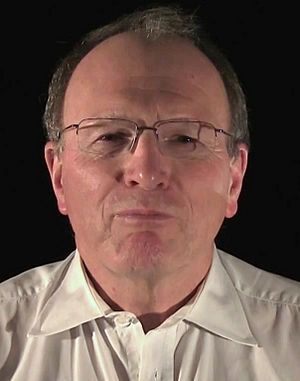Andrew Bruce Holmes facts for kids
Quick facts for kids
Andrew Holmes
|
|
|---|---|

Holmes in 2015
|
|
| Born |
Andrew Bruce Holmes
5 September 1943 Melbourne, Australia
|
| Nationality | Australian and British |
| Alma mater |
|
| Known for | Natural product synthesis, Organic electronics |
| Awards |
|
| Scientific career | |
| Fields | Organic Chemistry |
| Institutions | CSIRO University of Melbourne Imperial College London University of Cambridge |
| Doctoral advisor | Franz Sondheimer |
| Other academic advisors | Albert Eschenmoser (postdoc) |
| Doctoral students | Christine Luscombe |
| Other notable students | Andrew Ian Cooper (postdoc) |
Andrew Bruce Holmes, born on September 5, 1943, is a famous Australian and British chemist. He is a professor at the Bio21 Institute in Melbourne, Australia. He also used to be the President of the Australian Academy of Science.
Professor Holmes is known for his amazing work in chemistry. He studies how to create special materials. These include natural products that can be used as medicines or tools for science. He also works with polymers that glow, which are used in things like flexible screens and solar cells.
Contents
Becoming a Scientist
Andrew Holmes started his science journey at the University of Melbourne. There, he earned his first degrees. He then traveled to the United Kingdom. He studied for his PhD at University College London. His teacher there was a scientist named Franz Sondheimer.
Early Research and Teaching
After his PhD, Holmes worked as a researcher. He helped with a big project to create Vitamin B12. This was with another famous scientist, Albert Eschenmoser.
In 1972, he became a teacher at the University of Cambridge. He stayed there for 32 years! He became a professor of Organic and Polymer Chemistry. He also led the Melville Laboratory for Polymer Synthesis. He helped start this lab and guided it for its first ten years.
Amazing Discoveries
At Cambridge, Professor Holmes became very interested in making new molecules. These molecules could be useful in biology or everyday life. He worked on creating natural products, like those found in plants.
The Discovery of Light-Emitting Polymers
In 1989, something exciting happened in Holmes's lab. A researcher named Chloe Jennings was studying a new type of plastic, called a conductive polymer. She noticed that this plastic glowed when electricity passed through it!
This discovery led to a lot of new research. Holmes's team and other scientists found polymers that could glow in many different colors. These glowing plastics could cover the whole rainbow!
Working with Physicists
Professor Holmes then teamed up with a physicist named Richard Friend. They worked together at Cambridge's Cavendish Laboratory. They found that these special glowing plastics could be used to make organic LEDs. These are used in things like rollable displays, which are screens that can bend and roll up!
Holmes and Friend even started a company called Cambridge Display Technology. This company helped turn their discoveries into real products. It was a big success story for the technology area known as Silicon Fen.
Returning to Australia
In 2004, Professor Holmes moved back to Australia. He joined the new Bio21 Institute. There, he continued his research. He focused on using glowing polymers to make organic solar cells. These cells can turn sunlight into electricity. He also helped create the Victorian Organic Solar Cell Consortium. This group works on developing solar energy technology.
He also kept finding new ways to make useful biological materials. For example, his team created special molecules called phosphoinositides. Other scientists used these to study how cells communicate. This is important for understanding many things, including how tumors grow.
Sharing Knowledge
Professor Holmes has been part of many important science journals. He helped guide publications like Organic Letters and Chemical Communications. In 2006, one of his papers about glowing polymers was the most referenced paper in a famous journal called Angewandte Chemie. By 2012, he had written over 490 science papers and had 52 patents!
In 2014, he became the President of the Australian Academy of Science. This is a very important role in Australian science.
Awards and Recognition
Professor Holmes has received many awards for his amazing work.
- In 2000, he became a Fellow of the Royal Society. This is a very high honor for scientists.
- In 2006, he became a Fellow of the Australian Academy of Science.
- He won the Descartes Prize in 2003.
- In 2012, he received the Royal Medal from the Royal Society.
- He was also given the John B Goodenough Award in 2011.
In 2004, he was recognized for his service to science. He was made a Member of the Order of Australia. In 2017, he received an even higher honor, becoming a Companion of the Order of Australia. This was for his outstanding work in chemistry and for leading important science organizations. In 2021, he received the Matthew Flinders Medal and Lecture.
Personal Life
Outside of science, Professor Holmes enjoys hiking in the hills. He also loves classical music, from old baroque pieces to romantic operas. When he lived in Cambridge, he was a member of St Columba's United Reformed Church. Today, he lives in Melbourne and Lorne, Victoria with his wife, Jennifer.

